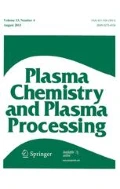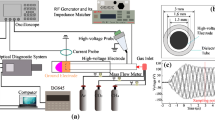Abstract
The discharge in mixtures of inert gas with sulfur vapors is an effective source of radiation spectrum, which is similar to solar in the wavelength range of 280–600 nm due to strong emission of S2 molecules (\( B{}^{3}\varSigma \to X{}^{3}\varSigma \)-transition). This phenomenon is utilized in microwave sulfur lamp. Despite a number of advantages microwave sulfur lamps have disadvantages that prevent their widespread use. This paper presents optical properties of the pulsed-periodic discharge in mixtures of argon with sulfur vapour in UV and visible spectral region and a global model of the discharge. Emission of the pulsed-periodic discharge in argon–sulfur vapour mixtures was studied at argon pressure up to 100 Torr and pressure of sulfur saturated vapors determined by temperature of gas-discharge tube walls varied due self-heating from the room temperature up to 160 °C. It is shown that strong band of S2 molecules are observed in the discharge emission in the wavelength range of 300–600 nm and S and Ar lines are predominate in the wavelength range of 600–1000 nm. Effect of the discharge conditions on emission spectra was investigated. Time profiles of plasma species densities under various Ar–S2 mixture compositions and voltage pulse up to 15 kV with duration ~ 10 μs were calculated using the global model. It is shown, that densities of S2* molecules fast increases at the voltage pulse beginning and reach maximum after ~ 2 μs, so strong radiation of S2* is characteristic for the time interval, then S2* density fast decreases.














Similar content being viewed by others
References
Ricard A, Sarrette JP (2019) Densities of active species in R/x%(N2–5%H2) (R = Ar or He) microwave flowing afterglows. PCPP 39:1103–1114
Yanez-Pacios AJ, Martin-Martinez JM (2018) Improved surface and adhesion properties of wood-polyethylene composite by treatment with argon-oxygen low pressure plasma. PCPP 38:871–886
Malik MA, Hughes D, Malik A, Xiao S, Schoenbach KH (2013) Study of the production of hydrogen and light hydrocarbons by spark discharges in diesel, kerosene, gasoline, and methane. PCPP 33:271–279
Su X, Feng M, Rogers S, Holsen TM, Mededovic Thagard S (2019) The role of high voltage electrode material in the inactivation of E. coli by direct-in-liquid electrical discharge plasma. PCPP 39:577–596
Barjasteh A, Eslami E (2018) Numerical investigation of effect of driving voltage pulse on low pressure 90%Ar–10%Cl2 dielectric barrier discharge. PCPP 38:261–279
Baeva M, Reiter D (2003) Monte Carlo simulation of radiation trapping in Hg–Ar fluorescent discharge lamps. PCPP 23:371–387
Zissis G, Kitsinelis S (2009) State of art on the science and technology of electrical light sources: from the past to the future. Topical review. J Phys D Appl Phys 42:173001
Malkov M (2011) Sulfur lamp. A promising start and… an unpredictable future? Part I. A bit of history and about the lamp device. Sovremennaya Svetotekhnika (Modern Lighting) 3:69–72
Malkov M (2011) Sulfur lamp. A promising start and… an unpredictable future? Part II. A little about the physics of sulfur discharge. Sovremennaya Svetotekhnika (Modern Lighting) 4:53–58
Malkov M (2011) Sulfur lamp. A promising start and… an unpredictable future? Part III. Technical characteristics of lamps and light distribution systems. Sovremennaya Svetotekhnika (Modern Lighting) 5:69–72
Műller P, Klán P, Církva V (2005) The electrodeless discharge lamp: a prospective tool for photochemistry Part 5: fill material-dependent emission characteristics. J Photochem Photobiol, A 171:51–57
Dolan JT, Ury MG, Wood CH (1992) Novel high efficacy microwave powered light source. VIth Intern Sym on the Science and Technology of Light Sources. Tech University Budapest (Lighting Sciences 6), pp 301–302
Long-life “super lamp” mimics bright sunlight (1994) Elec Rev 22:18
Childs AH, Schrenk WG (1976) Some characteristics of low pressure, sulfer, microwave-excited, electrodeless discharge lamps. Appl Spectrosc 30:507–509
Turner BP, Ury MG, Leng Y, Love WG (1997) Sulfur lamps - progress in their development. J Illum Eng Soc 26:10–16
Krizek DT, Mirecki RM, Britz SJ, Harris WG, Thimijan RW (1998) Spectral properties of microwave-powered sulfur lamps in comparison to sunlight and high pressure sodium/metal halide lamps. Biotronics 27:69–80
Chen Y, Chen D (2006) Study the buffer gas for microwave sulfur lamp. In: Conf record of the 2006 IEEE industry applications conf forty-first IAS annual meeting. Tampa, FL, USA. https://doi.org/10.1109/ias.2006.256746
Aleksandrova OYu, Bondarenko SM, Guttsayt EM, Zhidkov RA (2013) Plasma lighting devices based on microwave discharge. T-Comm Telecommun Transp 9:9–11
Johnston CW (2003) Transport and equilibrium in molecular plasmas: the sulfur lamp. PhD Thesis: Technische Universität Eidhoven
Van der Heijden HWP (2003) Modelling of radiative transfer in light sources. PhD Thesis: Technische Universität Eidhoven
Van der Heijden H, Van der Mullen J, Baier J, Körber A (2002) Radiative transfer of a molecular S2 B-X spectrum using semiclassical and quantum-mechanical radiation coefficients. J Phys B: At Mol Opt Phys 35:3633–3654
Johnston CW, Van der Heijden HWP, Janssen GM, Van Dijk J, Van der Mullen JJAM (2002) A self-consistent LTE model of a microwave-driven, high-pressure sulfur lamp. J Phys D Appl Phys 35:342–351
Heneral AA, Avtaeva SV (2017) Emission characteristics of plasma based on xenon-rubidium bromide mixture. Opt Spectrosc 123:531–534
Heneral AA, Avtaeva SV (2017) Emission characteristics of Xe–RbBr plasma. J Phys D Appl Phys 50:495202
Heneral AA, Zhmenyak YV (2018) Luminescent characteristics of a pulsed discharge plasma in Xe–KBr mixture. J Appl Spectrosc 85:79–83
Avtaeva SV, General AA, Kel’man VA (2010) Kinetic model for low-density non-stationary gas discharge in water vapour. J Phys D Appl Phys 43:315201
Shuaibov AK, Heneral AA, Shpenik YuO, Zhmenyak YuV, Shevera IV, Gritsak RV (2009) Ultraviolet radiation sources on (H2O, D2O) water vapor. Tech Phys 54:1238–1240
General AA, Kelman VA, Zhmenyak YuV, Zvenigorodsky VV (2016) Optical radiation of a gas discharge in argon–sulfur mixture. J Appl Spectrosc 83:598–602
Kikoin IK (ed) (1976) Tables of physical quantities. Handbook (p 201). Atomizdat, Moscow
Zavilopulo AN, Shpenik OB, Markush PP, Mykyta MI (2014) Tech Phys Lett 40:13–17
Avtaeva SV, Avdeev SM, Sosnin EA (2010) Radiation of nitrogen molecules in a dielectric barrier discharge with small additives of chlorine and bromine. Plasma Phys Rep 36:719–728
Rau H, Kutty TRN, Guedes de Carvalho JRF (1973) Thermodynamics of sulphur vapour. J Chem Thermodyn 5:833–844
Ferreira AGM, Lobo LQ (2011) The low-pressure phase diagram of sulfur. J Chem Thermodyn 43:95–104
PHELPS database http://www.lxcat.laplace.univ-tlse.fr
Tashiro M (2008) Exchange effects in elastic collisions of spin-polarized electrons with open-shell molecules with 3Σ −g symmetry. Phys Rev A 77:012723
Johnson TH, Cartland HE, Genoni TC et al (1989) A comprehensive kinetic model of the electron-beam-excited xenon chloride laser. J Appl Phys 66:5707–5725
Bassett NL, Economou DJ (1994) Effect of Cl2 additions to an argon glow discharge. J Appl Phys 75:1931–1939
Klucharev N, Vujnovid V (1990) Chemi-ionization in thermal-energy binary collisions of optically excited atoms. Phys Rep 185:55–81
Moravej M, Yang X, Barankin M, Penelon J, Babayan SE, Hicks (2006) RF properties of an atmospheric pressure radio-frequency argon and nitrogen plasma. Plasma Sources Sci Technol 1(5):204–210
Dyatko NA, Ionikh YZ, Kochetov IV, Marinov DL, Meshchanov AV, Napartovich AP, Petrov FB, Starostin SA (2008) Experimental and theoretical study of the transition between diffuse and contracted forms of the glow discharge in argon. J Phys D Appl Phys 41:055204
Tashiro M (2008) Electron impact excitations of S2 molecules. Chem Phys Lett 453:145–149
Freund RS, Wetzel RC, Shul RJ (1990) Measurements of electron-impact- ionization cross sections of N2, CO, CO2, CS, S2, CS2, and metastable N2. Phys Rev A 41:5861–5868
Coat YL, Bouby L, Guillotin JP, Ziesel JP (1996) Negative ion formation by electron attachment in S2 and in the sulphur vapour. J Phys B: At Mol Opt Phys 29:545–553
Chernii GG, Losev SA (eds) (1995) Physico-chemical processes in gas dynamics. Vol 1 Dynamics of physic-chemical processes in gas and plasma. Moscow University Publishing, Moscow
Zatsarinny O, Tayal SS (2002) Electron impact collision strengths and rates for neutral sulphur using the B-spline R-matrix approach. J Phys B: At Mol Opt Phys 35:2493–2503
Eletskiy AV, Smirnov BM (2000) Elementary processes in plasma. In: Fortov VE (ed) Encyclopedia of low-temperature plasma. Introductory, vol 1. Nauka, Moscow
Tinck S, Boullart W, Bogaerts A (2011) Modeling Cl2/O2/Ar inductively coupled plasmas used for silicon etching: effects of SiO2 chamber wall coating. Plasma Sources Sci Technol 20:045012
Kuznetsova LA, Kuzmenko NE, KuzyakovYuYa, PlastininYuA (1980) Transition probabilities of diatomic molecules. In: Khokhlov RV (ed) Moscow: Nauka
Radtsig AA, Smirnov BM (1978) Hand-book on atomic and molecular physics. Atomizdat, Moscow
Hagelaar GJM, Pitchford LC (2005) Solving the Boltzmann equation in the two-term approximation to obtain electron transport coefficients and rate coefficients for fluid models. Plasma Sources Sci Technol 14:722–733
Brotton SJ, McConkey JW (2011) Electron-impact dissociative excitation of S2. J Phys B: At Mol Opt Phys 44:215202
Yamabe C, Buckman SJ, Phelps AV (1983) Measurement of free-free emission from low-energy-electron collisions with Ar. Phys Rev A 27:1345–1352
Brown PN, Byrne GD, Hindmarsh AC (1989) VODE: a variable-coefficient ODE solver. SIAM J. Sci. Stat. Comput 10(5):1038–1051
Lieberman MA, Lichtenberg AJ (1994) Principles of plasma discharges and materials processing. Wiley, New York
Acknowledgements
The authors are very grateful to Profs. V. A. Kelman and Yu. V. Zhmenyak for help in performing the experiments, advices and useful scientific discussions.
Author information
Authors and Affiliations
Corresponding author
Additional information
Publisher's Note
Springer Nature remains neutral with regard to jurisdictional claims in published maps and institutional affiliations.
Rights and permissions
About this article
Cite this article
Avtaeva, S.V., Heneral, A.A. The Pulsed Periodic Discharge in Mixtures of Ar with Sulfur Vapour. Plasma Chem Plasma Process 40, 839–855 (2020). https://doi.org/10.1007/s11090-020-10067-1
Received:
Accepted:
Published:
Issue Date:
DOI: https://doi.org/10.1007/s11090-020-10067-1



